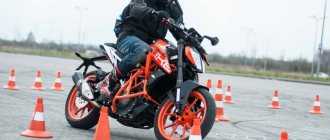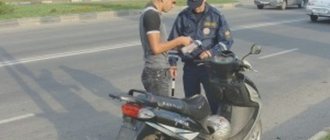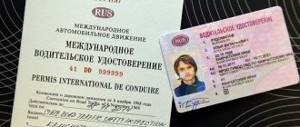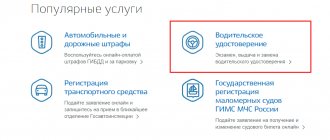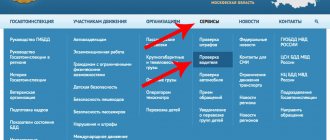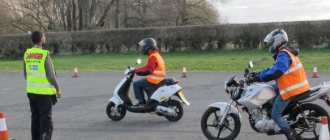AutoYurait.rf / Driver's license
Back
Published: 12/31/2018
Reading time: 5 min
0
1602
According to Russian laws, any driver driving on the roads must have an appropriate license. And it doesn’t matter how many wheels your vehicle has - four or just two. Relatively recently, the requirements for motorcycle and scooter drivers were more flexible. Since 2013, the situation has changed radically and even a scooter driver is required to undergo training at a motorcycle school.
- Motorcycle license: is it possible to do without them?
- At what age can you drive a motorcycle?
- What categories of motorcycle rights are allocated in 2021? Rights for a motorcycle with a sidecar
- Moped and scooter licenses
- Documents of the future driver
Motorcycle license: is it possible to do without them?
The law is adamant. If you are not going to sit behind the wheel of a bicycle forever, but plan to at least occasionally get behind the wheel of at least a moped, a license is required. And this is not a whim of traffic police inspectors and motorcycle schools who want to “extract” more money from you.
A qualified driver who has undergone training clearly knows how to behave in a given traffic situation. While the “disenfranchised” driver only guesses about the correctness of his behavior on the road. And it’s good if such driving only ends with a fine and confiscation of the two-wheeled horse.
Don’t even hope that the weak engine of your scooter will be a mitigating circumstance when meeting with traffic police officers. No one has canceled age restrictions either.
But owners of motocross motorcycles can breathe easy. They do not face fines or confiscation of the vehicle for driving without a license. But as long as they remain on the territory of sports tracks.
The reason for the “indulgence” is simple: a motocross motorcycle belongs to the category of sports equipment. And as long as its owner races on dirt tracks, he does not break any rules.
At what age can you drive a motorcycle?
This parameter is directly related to the type of two-wheeled vehicle that the driver plans to drive. There are motorcycles that you can drive no earlier than 18 years old. But there are categories of vehicles available for driving from the age of 16.
| Scooters, mopeds | Engine capacity not exceeding 50 cubic meters | From 16 years old |
| Light motorcycles | Engine capacity up to 125 cc | From 16 years old |
| Motorcycles | Engine capacity is more than 125 cubic meters | From 18 years old |
| Tricycles, ATVs | Engine capacity from 50 cubic meters | From 18 years old |
More on the topic: How to get a certificate from a drug treatment center?
You are allowed to start learning how to operate a motorcycle long before your 18th birthday. But be patient, you will be allowed to take the exams only when you reach this age.
What categories of motorcycle licenses are there in 2018?
The motor market is ready to offer a huge selection of motorcycles. How not to get confused in this diversity and understand which category is needed to control a particular two-wheeled horse? The classification decided everything.
Since motorcycles are different, it was decided to distinguish three categories: “M”, “A”, “A1”. Each of them makes it possible to control motorcycles with different weights and engine sizes.
| Category “M” Appeared in 2013 | Engine capacity not exceeding 50 cubic meters | Mopeds (tricycles, scooters); quads; mokiki; scooters |
| Category “A1” (most common among teenagers) | engine capacity from 50 to 125 cubic meters; maximum power – up to 11 kW. | Light motorcycles |
| Category "A" | engine capacity up to 125 cubic meters; vehicle weight in running order up to 400 kg | Motorcycles |
If the future driver has already crossed the 18-year mark, it makes sense to study for category “A”. In this case, “M” and “A1” will be given to him as bonuses. The significant date is far away, but you really want to drive, choose “M” or “A1” - depending on your vehicle.
License for a motorcycle with a sidecar
Are you planning to buy a motorcycle with a sidecar? Hurry up to get your category “A” license. For your own safety, do not be lazy to take a couple of lessons on riding such a motorcycle.
This type of transport is fundamentally different from its two-wheeled counterpart. Because of the stroller on one side, it takes up much more space on the road. And this requires a special habit.
Moped and scooter licenses
The emergence of the “M” category has made life easier for owners of scooters and mopeds. Having reached 16 years of age, complete training at a motorcycle school and freely ride lightweight vehicles.
If the driver has been trained for category “A”, then “M” is entered automatically. What gives you the right to drive a light scooter.
Which vehicles are included in categories A, A1 and M
Before enrolling in a driving school, it would not hurt the future driver to find out all the details about opening a category A driver’s license and what it is all about. Category A includes heavy motorcycle vehicles. This fully equipped vehicle can weigh up to 400 kg, and the working engine capacity is more than 125 cm cubic.
Such a motorcycle can also be equipped with a sidecar (or side trailer), although over the past few decades this device has been used extremely rarely by motorcyclists. This category also includes powerful 3- and 4-wheeled vehicles, but with a total weight within the same 400 kg.
Category A gives the driver the right to drive vehicles of two more categories:
- A1 is a subcategory. These are the same motorcycles, only with smaller engine capacity - in the range of 50-125 cm3, and power is allowed up to 11 kW. This also includes 3-wheeled vehicles weighing up to 550 kg, the maximum speed of which is limited to 45 km/h.
- M – mopeds, scooters and other light vehicles, whose engine volume is not higher than 50 cm3. Light ATVs are in the same category. For some time now, all these vehicles have gained immense popularity among drivers, since they do not require training or wearing a helmet. But it's that widespread prevalence that has forced lawmakers to tighten the rules.
Each category of motorcycle has its own age standards:
- Category A licenses will be available to citizens over 18 years of age.
- Driving category A1 is available from 16 years of age. Automatically opens if you receive category A.
- Category M provides special training only for citizens aged 16 years or older who do not have any driving license, since it can be opened automatically if you have a license for any category of driving.
For each of the classification categories, training can be completed before the specified age (at 14-15 years old for A1 and M, from 16 years old for A), but you will be able to pass the exam and receive a document (driver’s license) only upon reaching the required date.
When a driver receives category A, A1 or M, a note about this is made on the back of the license, in the corresponding line and column. Restrictions are entered in the adjacent column.
Driver requirements
- The future driver must be healthy; the appropriate certificate is obtained before the start of the training course. It would be a shame to take a course at a motorcycle school and find yourself unfit for health.
When undergoing a medical examination, warn the medical commission about your desire to open the “M” category. If you do not do this, the category will not appear in your rights. You will not be able to drive a moped.
- Reaching a certain age – each category has age parameters;
- Completion of training at a motorcycle school corresponding to the required category.
Obtaining rights: specifics
To obtain a motorcycle license, you do not have to take the traditional city exam for obtaining any other license. In the case of a motorcycle, traffic police inspectors are limited to checking theoretical knowledge of traffic rules. Testing of practical skills takes place in special training grounds and sites.
Until the newly minted motorcyclist passes the theoretical course, he will not be allowed to take practical tests. In case of failure, retaking the theory is allowed after 2 weeks.
Some schools refuse to enroll in motorcycle riding courses in the winter. This is due to the complexity of road conditions. It is difficult to teach an inexperienced driver all the subtleties of driving on slippery roads.
Documents of the future driver
Until the applicant submits a full package of documents, he simply will not be allowed to study.
- Copy of the passport.
- Certificate with a conclusion from the medical board.
- 2 photos 3x4.
- Statement.
- A document confirming the fact of successful training in a motorcycle school.
- Payment for payment of state duty.
- Consent from parents - if the future motorcyclist is under 18 years of age.
Procedure for obtaining a driver's license
This procedure also has its own course of events.
- Checking the authenticity of each piece of paper - rest assured, the chance with false documents will definitely not work here;
- The applicant for a license receives access to testing;
- The first stage of exams is theory;
- The second stage is practice at a special training ground;
- Obtaining a driver's license.
Passing exams: step by step
The exam is divided into two independent blocks: theoretical and practical. The first involves testing the theoretical framework and rules. The second is aimed at identifying practical skills and abilities.
The theoretical part is taken entirely computer-based. During the test for knowledge of traffic rules, the test taker answers 20 questions. Ideally, the number of errors is zero.
20 minutes of time are allotted for the test - one minute per question. If one mistake is made, another 5 minutes are added to the time. During these minutes you need to answer an additional 5 questions from the block where the mistake was made.
If you make mistakes on 2 questions, 10 minutes and 10 questions are added to the time. If you miss 3 questions, the examinee is sent to retake.
The practical side of the exam takes place in the fresh air - at the training ground. Here everything is like at school, for a mistake - a minus to the final mark. It is enough to score 4 penalty points to be considered for a retake.
Minus 1 point for:
- a warning signal not given by hand about planned braking;
- late braking before the stop line;
- low beam lights not turned on.
Minus 3 points for:
- stalled engine at the beginning of the exam;
- untimely switching from upshift to downshift, and vice versa;
- ignoring neutral gear when the motorcycle stops for a long time;
- untimely warning of turns.
Minus 5 points for:
- arrival and crossing of the stop line;
- touching the ground with your foot;
- hitting a barrier sign;
- ignoring the left turn signal;
- significant shortfall to the stop line.
Upon successful completion of all tests, the student moves to the “driver” category. Now all that remains is to obtain the long-awaited license of the appropriate category.
The validity period for a motorcycle license is the same as for a car license – 10 years.
Procedure for obtaining rights
Those who are interested in how to obtain a motorcycle license need to know that training must initially be completed. After which a package of documents is collected and time is allotted to pass the exam.
In some motorcycle schools, training takes place in all seasons except winter, as it involves a large number of practical tasks that are problematic to complete in winter.
It is important to know that in addition to training, you should undergo a full medical examination. The goal of doctors is to see whether, due to health reasons, a person can drive a light-duty vehicle.
People with such disabilities are not allowed to ride a motorcycle.
- Poor eyesight. If a potential driver's visual acuity is from 0.2 to 0.6 units, he will not be allowed to drive a vehicle. If it is determined that he sees 70 - 100%, he is allowed to drive.
- Chronic eye diseases. These are aberrations, amblyopia, asthenopia, angliopathy, astigmatism, blephavitis, myopia, etc.
- Obvious strabismus.
- Signs of color blindness.
- Glaucoma of the eye.
- Limited vision (up to 20%), which does not allow the driver to see other drivers on the road.
- Deformation of the skull.
- Disability in the absence of one limb.
- Complete or partial deafness.
- Disorders of the vestibular apparatus.
- Heart diseases.
- Bronchial asthma and other related diseases that are rapidly developing.
- Disorders of gynecological functions.
Particular attention is paid to the mental state of the future driver. There should be no deviations, especially phobic disorders. This can create an emergency situation on the road.
After a medical examination, a person receives information about his state of health, issued in accordance with Order of the Ministry of Health No. 302.
Motorcycle driving training
This is the first step towards obtaining a driver's license. Training for all 3 categories is, in principle, not very different.
First, basic motorcycle riding skills are taught. The main technically necessary parts of the vehicle (assemblies, mechanisms, spare parts) are studied. The main thing is to understand exactly how a motorcycle works and what are the features of driving a vehicle in different categories.
Riding a motorcycle involves studying the following aspects:
- vehicle structures;
- legislative framework;
- providing first aid;
- correct positioning of the driver and other passengers in transport;
- lateral vision;
- braking skills, using the rear and front brakes (up to a complete stop);
- safe start;
- driving with one hand (basic principles);
- quick gear changes;
- turning on a motorcycle at minimum and maximum speed;
- driving a vehicle in emergency situations;
- driver behavior in an accident;
- balancing on sharp turns;
- developing a sense of the dimensions of the selected vehicle (a special set of exercises and maneuvers is studied);
- features of driving over the bridge and across railway tracks;
- driving skills on a circular route, etc.
After this, they are tested (this is not an exam, but educational verification tests). If the result is successful, the student is allowed to take practical classes.
In practice, students learn the above and basic maneuvers:
- travel "snake";
- driving along the board;
- stopping at the stop line, etc.
Motorcycle schools offer different training packages. It can be basic or simplified. Usually consists of 10 - 12 lessons lasting up to 90 minutes. If the course is in-depth or complete, then the training is designed for 15 - 20 lessons, where 6 - 8 lessons will be devoted to practical development of the acquired theoretical knowledge. Each practice lesson lasts at least 1.5 hours, but more often 2.
The focus of the training is to successfully pass the traffic police exam and develop the skills to fearlessly drive a motorcycle of the selected category.
Required documents to obtain rights
After the courses are completed, you need to collect the necessary package of documents. He is sent to the traffic police.
You will need the following documents:
- Application on an approved form. The sample is taken at a driving school, on the website or at the traffic police department.
- Passport with registration.
- Check or receipt for payment of state duty. Its size is 2,000 rubles.
- Certificate of training and completion. A copy is submitted along with the original.
- Medical certificate. Just like a certificate, both a copy and an original are needed.
- Two photographs measuring 3.5 by 4.5 cm.
These documents are registered in order of priority. If there are no problems (absence of some document, forgery, etc.), the traffic police officer sets the place, date and time of the exam. The place of residence or registration of the future driver is taken into account.
Exam procedure
Students who have completed the entire training course and received a medical certificate confirming that they can drive a motorcycle are allowed to take the exam. The exam consists of 2 parts – theoretical and practical. If the theory is unsuccessful, the person is not allowed to take the practical part of the test, but is sent to retake it.
What does successfully passing the traffic police exam depend on? Read about this and much more in our specialist’s material.
Theoretical part
Consists of 20 questions. The applicant is allowed to make a maximum of 2 mistakes. Now testing is taking place on computers. The program has more than 500 questions to test knowledge of traffic rules, transport structure, etc.
If a person makes more than 2 mistakes, the exam automatically ends. This is indicated by the program automatically turning off. In this case, the student is sent to retake. It is prescribed no earlier than 5 days after the previous test.
The results of theoretical testing are valid only for 3 months. After this period, to pass the practical part of the exam, you will have to take the theory tests again.
Practical part
Involves the execution of an appropriate set of maneuvers. The classic set consists of maneuvering exercises in confined spaces. Includes 4 maneuvers, of which the examiner selects 3. Their list:
- Dimensional eight. The candidate’s task is to drive along a given trajectory without moving beyond its boundaries. The examiner sets out 4 cones, which the person must drive around along a figure-eight trajectory.
- Snake. A “snake”-shaped trajectory is created using 3 cone shapes.
- Large corridor. Includes correct neutral transmission and keeping the vehicle stationary.
- High-speed maneuvering. According to the students, the most difficult maneuver. An arrangement of 5 cones is made, which must be driven around on the right or left side. During the process, the applicant passes 3 clearance gates. The execution time for this maneuver is 35 seconds or less.
Maneuvering is performed on an automated racing track or closed area. If the exam is passed successfully, the person receives a driver's license. Licenses are issued 5 - 7 working days after presentation of the passport. The package of necessary documents is transferred by the motorcycle school to the MREO.
If the student has not completed all 3 maneuvers, then he is sent to retake. The date is set 5 days after the first test attempt.
When can you do without special training?
You can get out of compulsory training at a motorcycle school. But if the future driver does not plan to drive a vehicle over 50 cubic meters. The existing rights with any category will suffice.
If the driver has not managed to acquire a driver’s license, then training at a motorcycle school will not be possible. You just need to decide on the resulting category.
Don’t like to overpay, but want to have the “M” category in your arsenal? Save, “open” category “A” and higher, and “M” will be provided to you as a bonus. You will not need to take any additional exams.
How much will it cost to obtain rights?
Many drivers are interested in how much a motorcycle license costs in 2019. Although the vehicle itself is not very expensive (compared to a car), you will have to spend a lot of money to obtain a driving license.
Main cost items:
| Name of cost item | Payment amount |
| State duty | The price also includes obtaining a plastic driver's license. The total cost is 2,000 rubles. |
| Medical certificate | In 2021, on average it costs 1.5 - 2,000 rubles. If the clinic is private, the payment may be 2 times higher. |
| Tuition payment | The price varies depending on the training package. Many motorcycle schools make a tempting offer - pay a little more, but immediately get not only category A, but also A1 and M. This is very convenient for drivers. On average, the price of training is 15 - 25,000 rubles. But in some seasons or a few days before the start of training, if there are free places, they offer discounts (usually up to 30%), which will also allow you to save. |
| Payment for exams | Theory is cheaper. Together with practice, the price varies from 3 to 5,000 rubles. |
Training can be carried out in a course or individual lessons. The average payment for 1 lesson is 500-1,000 rubles. Time 45 - 50 minutes. Typically, such an offer is valid if you want to take additional practical classes.
If we add up, then obtaining a driver’s license of categories A, A1 and M will cost 25 - 30 thousand rubles. This is 2 times cheaper than learning to drive a car, where only the cost of theory and practice is 27 - 40 thousand rubles.
How to get a motorcycle license if you have category “B”?
Open category “B” does not give its owner the right to drive a motorcycle over 50cc. You'll have to sit down at your desk again and go through the DD rules again. Only after successfully passing the oral part of the exam will the driver be allowed to take the practical test.
Some people will be outraged by this approach - why learn the rules, all this has been covered. It's not about the traffic rules themselves, but about the specifics of driving a motorcycle. Driving a car is very different from riding a two-wheeler.
However, if you feel strong enough, you don’t have to attend a motorcycle school. Practice your motorcycle riding skills on your own. But where is the guarantee that you are performing all the elements correctly?
Still, it’s worth playing it safe and taking a lesson or two from an experienced driver-instructor. He will clearly explain the requirements for the exams.
Motorcycle driver's license
In our country, all types of driver's licenses are issued at traffic police departments. To obtain them, you must pass all qualification tests. Currently, the entire procedure for issuing licenses of any category is regulated by the law on the rules for passing all necessary exams and issuing a driver’s license. It was adopted at the end of the last century. However, it came into force at the beginning of the new millennium. It has been operating since 2001.
In order to obtain a category A license, you must undergo special training in institutions designed to train motorcyclists. A person receives admission to the exams only when, under the guidance of specialists from a motorcycle school, he has listened to the entire theoretical part and acquired the skills to operate a motorcycle.
After the theoretical and practical parts, it is mandatory to submit documents for registration. The traffic police license category A is issued to everyone who is already sixteen years old.
If you have category B, then you are able to drive vehicles that weigh no more than three and a half tons. With such a license, the number of passengers in a vehicle should not exceed eight people. If you are tired of endless traffic jams and want to switch to a more maneuverable vehicle, then if you have category B, getting a driver’s license will not be difficult.
You will have one very serious advantage. It lies in the fact that in some cases, holders of such licenses do not need to pass the theoretical rules of driving vehicles.
Attention: This rule for issuing a driver’s license for a motorcycle with category B applies only when the period for passing the theoretical exams to obtain it does not exceed three months.
If the deadline for passing the theoretical part of the exam was more than three months ago, then obtaining a category A license is carried out according to the general rules.
Price issue
Everything here is individual. There are several factors that significantly influence the final tuition amount.
- Region – studying in a large city will cost an order of magnitude more than in a small provincial town.
- Educational institution - the more regalia a school has, the more expensive the services of its teachers.
- Medical institution where the certificate was received.
The only “fixed” figure is the state fee for obtaining a license. It is the same for all regions and does not depend on the skill of teachers.
